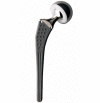Fixation of Trochanteric Fragments in Cementless Bipolar Hemiarthroplasty of Unstable Intertrochanteric Fracture: Cerclage Wiring
- PMID: 29250501
- PMCID: PMC5729169
- DOI: 10.5371/hp.2017.29.4.262
Fixation of Trochanteric Fragments in Cementless Bipolar Hemiarthroplasty of Unstable Intertrochanteric Fracture: Cerclage Wiring
Abstract
Purpose: Bipolar hemiarthroplasty (HA) is an option for the treatment of unstable intertrochanteric fracture in elderly patients. There is a raising concern regarding cable-grip related complications for the fixation of trochanteric fragments. Therefore, the aim of this study was to evaluate outcome of cementless HA with fixation for the trochanteric fragments using monofilament wires in unstable intertrochanteric fracture.
Materials and methods: We reviewed 92 cementless bipolar HAs using a grit-blasted long stem design for unstable intertrochanteric fractures in 91 elderly patients with a mean age of 81.7 years. During the arthroplasty, trochanteric fracture fragments were fixed using 1 or 2 vertical wires and transverse wires. We evaluated the clinical outcomes such as abductor power, ambulatory ability and wire-related complications, and radiologic outcomes including the union of the trochanteric fragment and subsidence of stem.
Results: Sixty-two patients were followed for a minimum of 2 years (mean, 59 months) postoperatively. The mean abductor power and Koval category was 4.1 (range, 3 to 5) and 4.6 (range, 1 to 6). The wire was broken in 3 hips (4.8%) and the nonunion of the greater trochanter occurred in 1 hips (1.6%). Two stems subsided by 3 mm and 8 mm, respectively, during postoperative 6 weeks, after which the subsidence was not progressive.
Conclusion: Cerclage wiring of the trochanter using monofilament wire leads to acceptable outcome in cementless HA for senile patients with unstable intertrochanteric fracture. Cerclage wiring using a monofilament wire is recommended for the fixation of trochanteric fragments.
Keywords: Cementless stem; Hemiarthroplasty; Hip fracture; Wiring technique.
Conflict of interest statement
CONFLICT OF INTEREST: The authors declare that there is no potential conflict of interest relevant to this article.
Figures





Similar articles
-
Bipolar Hemiarthroplasty in Unstable Intertrochanteric Fractures with an Effective Wiring Technique.Hip Pelvis. 2023 Jun;35(2):99-107. doi: 10.5371/hp.2023.35.2.99. Epub 2023 Jun 2. Hip Pelvis. 2023. PMID: 37323545 Free PMC article.
-
Bipolar hemiarthroplasty using microarc oxidation-coated cementless stem in patients with unstable intertrochanteric fracture.J Orthop Surg (Hong Kong). 2019 May-Aug;27(2):2309499019847815. doi: 10.1177/2309499019847815. J Orthop Surg (Hong Kong). 2019. PMID: 31084266
-
Cementless bipolar hemiarthroplasty for unstable intertrochanteric fractures in octogenarians.Acta Orthop Traumatol Turc. 2014;48(4):424-30. doi: 10.3944/AOTT.2014.13.0119. Acta Orthop Traumatol Turc. 2014. PMID: 25230266
-
Mid-Term Follow-Up Results After Hemiarthroplasty Using Long Femoral Stem Prosthesis (Peerless-160) for Intertrochanteric Fractures in Octogenarians.Geriatr Orthop Surg Rehabil. 2023 Jun 18;14:21514593231184314. doi: 10.1177/21514593231184314. eCollection 2023. Geriatr Orthop Surg Rehabil. 2023. PMID: 37360575 Free PMC article. Review.
-
Proximal femoral nailing is superior to hemiarthroplasty in AO/OTA A2 and A3 intertrochanteric femur fractures in the elderly: a systematic literature review and meta-analysis.Int Orthop. 2020 Apr;44(4):623-633. doi: 10.1007/s00264-019-04351-9. Epub 2019 Jun 14. Int Orthop. 2020. PMID: 31201487
Cited by
-
Short-Term Outcomes of a Reinforced Greater Trochanter Stabilization Technique in Revision Total Hip Arthroplasty After Periprosthetic Fracture: A Novel Technique and Case Series.Arthroplast Today. 2025 Jul 29;34:101779. doi: 10.1016/j.artd.2025.101779. eCollection 2025 Aug. Arthroplast Today. 2025. PMID: 40761692 Free PMC article.
-
Non-metallic cerclage fixation methods for proximal femoral osteotomy and periprosthetic hip fractures offer promising outcomes: A systematic review.J Orthop. 2023 Nov 14;47:8-17. doi: 10.1016/j.jor.2023.11.021. eCollection 2024 Jan. J Orthop. 2023. PMID: 38046452 Free PMC article. Review.
-
Uncemented hemiarthroplasty may have a role in the treatment of unstable intertrochanteric fractures in elderly patient. A survival complications and functional outcomes analysis.Int J Burns Trauma. 2023 Jun 15;13(3):126-135. eCollection 2023. Int J Burns Trauma. 2023. PMID: 37455800 Free PMC article.
References
-
- Zhang B, Chiu KY, Wang M. Hip arthroplasty for failed internal fixation of intertrochanteric fractures. J Arthroplasty. 2004;19:329–333. - PubMed
-
- Hsu CJ, Chou WY, Chiou CP, Chang WN, Wong CY. Hemi-arthroplasty with supplemental fixation of greater trochanter to treat failed hip screws of femoral intertrochanteric fracture. Arch Orthop Trauma Surg. 2008;128:841–845. - PubMed
-
- Haidukewych GJ, Berry DJ. Hip arthroplasty for salvage of failed treatment of intertrochanteric hip fractures. J Bone Joint Surg Am. 2003;85-A:899–904. - PubMed
-
- Kayali C, Agus H, Ozluk S, Sanli C. Treatment for unstable intertrochanteric fractures in elderly patients: internal fixation versus cone hemiarthroplasty. J Orthop Surg (Hong Kong) 2006;14:240–244. - PubMed
LinkOut - more resources
Full Text Sources
Other Literature Sources
Miscellaneous

